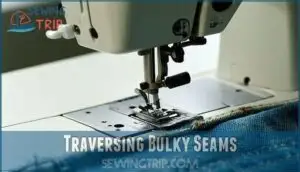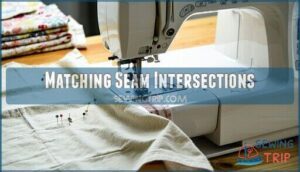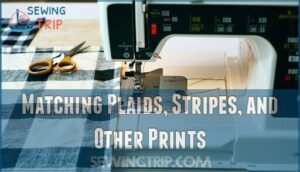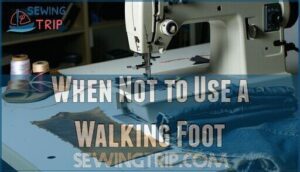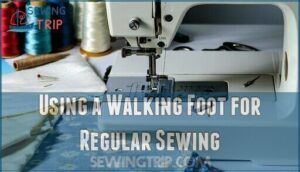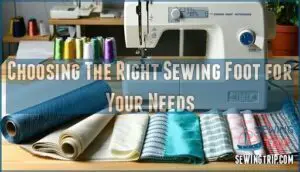This site is supported by our readers. We may earn a commission, at no cost to you, if you purchase through links.
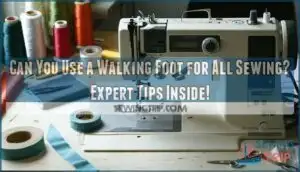
This specialized foot excels when you’re wrestling with multiple fabric layers, matching plaids, or traversing bulky seams where even fabric feeding matters most.
However, it’ll actually work against you on delicate materials, tight curves, or precision work where you need maximum control and maneuverability.
Think of it as your heavy-duty specialist rather than your everyday workhorse.
While your regular presser foot handles most general sewing with finesse, the walking foot steps in when fabrics start misbehaving or layers get unruly.
Knowing exactly when to swap them makes all the difference, and using the walking foot as your specialized foot for certain tasks can be very beneficial, especially when dealing with bulky seams or multiple fabric layers.
Table Of Contents
Key Takeaways
- You can’t use a walking foot for every sewing task—it’s a specialized tool that excels at specific challenges, like multiple layers, bulky seams, and pattern matching, but it’ll work against you on delicate materials and tight curves.
- Your walking foot prevents fabric shifting and puckering by using synchronized feed dogs that move both the top and bottom fabric layers at identical speeds, unlike regular presser feet that only grip the top layer.
- Skip the walking foot for leather, plastics, and extremely heavy fabrics—these materials need specialized non-stick or Teflon feet instead, as walking feet can create drag and uneven feeding on slippery or sticky surfaces.
- Think of your walking foot as your heavy-duty specialist rather than your everyday workhorse—use your regular presser foot for most general sewing and switch to the walking foot when fabrics start misbehaving or layers get unruly.
A Walking Foot Isn’t Just for Quilting!
You’ve probably pigeonholed your walking foot as strictly a quilting tool, but that’s like using a Swiss Army knife only for opening cans.
This versatile attachment transforms your sewing accuracy across countless projects, delivering superior fabric control that’ll make you wonder how you ever managed without it.
Walking foot sewing excels beyond quilting because of its unique foot mechanics. While regular presser feet only grip the top fabric layer, walking foot attachment features synchronized feed dogs that move both top and bottom layers at identical speeds.
This dual-action prevents the dreaded fabric shifting that plagues multi-layer projects.
Your stitch quality improves dramatically when tackling challenging materials. Slippery satins, stretchy knits, and bulky denims all benefit from this enhanced control. The walking foot for sewing handles everything from delicate silk blouses to heavyweight canvas bags with equal finesse.
Machine compatibility varies, so check your manual before purchasing. However, most modern machines accommodate walking foot quilting attachments. Once you experience this level of precision, you’ll reach for it far more often than you’d expect.
What is a Walking Foot?
A walking foot transforms your sewing machine into a precision feeding system.
This specialized presser foot attachment features its own set of feed dogs on top that work in perfect harmony with your machine’s built-in feed dogs underneath.
Like having an extra pair of hands guiding your fabric through every stitch.
Think of it as giving your fabric layers a gentle escort through the sewing process—no more fabric shifting or uneven stitches.
The walking foot’s magic lies in its synchronized movement.
While regular presser feet only hold fabric down, this attachment actively grips and moves the top layer at the same pace as the bottom layer.
It’s like having an extra pair of hands guiding your project.
Here’s what makes walking foot sewing so effective:
- Dual feed system – Top and bottom feed dogs work together
- Even fabric movement – Prevents layers from shifting or bunching
- Consistent stitch quality – Eliminates puckering and distortion
- Versatile compatibility – Works with various sewing machine feet attachments
This walking foot attachment isn’t just another sewing machine accessory—it’s your secret weapon for professional-looking results.
Understanding the proper walking foot techniques is essential for achieving the best outcomes in your sewing projects.
When to Use a Walking Foot
You’ll reach for your walking foot when regular sewing creates frustrating fabric shifting or uneven feeding.
This specialized attachment excels at managing challenging situations where multiple layers, thick seams, or tricky fabrics would otherwise cause puckering or misalignment, and it helps with uneven feeding.
Traversing Bulky Seams
When you’re sewing thick fabric or working through heavy seams, your regular presser foot might struggle.
A walking foot’s dual feed system grips both fabric layers, preventing the dreaded bunching that makes sewers everywhere groan.
This even feed foot eliminates fabric shifting at bulky seams, maintaining perfect alignment where waistbands meet side seams.
No more wrestling with your machine—the walking foot handles bulk handling like a pro, giving you complete fabric control over challenging seam traversal.
The walking foot is particularly useful for managing fabric layers evenly, making it a valuable tool for sewers who need complete fabric control and want to prevent fabric shifting with perfect alignment.
Matching Seam Intersections
Perfect seam alignment becomes achievable when you harness your walking foot’s dual feed system to synchronize fabric layers at intersection points.
This even feed foot prevents the dreaded "fabric drift" that turns crisp corners into wonky disasters.
Here’s your roadmap to intersection mastery:
- Pin strategically – Place pins perpendicular to seams, removing them as you approach the needle
- Use stitch in the ditch guide – This attachment keeps your needle perfectly aligned with existing seams
- Slow your speed – Precision matching requires deliberate pacing, not NASCAR-style rushing
- Check alignment frequently – Stop with needle down to verify intersection points match before continuing
- Press seams open – Reduces bulk at intersection points, allowing smoother fabric movement
Your dual feed foot maintains consistent stitch quality while preventing layers from shifting during those pivotal moments when multiple seams converge.
Matching Plaids, Stripes, and Other Prints
Pattern matching becomes effortless when you harness your walking foot’s dual feed system.
Unlike standard presser feet that let top fabric layers shift during sewing, a walking foot grips both layers simultaneously, maintaining perfect print alignment from start to finish.
Whether you’re tackling bold plaid patterns or delicate stripe sewing, this tool prevents the frustrating mismatches that plague complex textile design projects.
The even feed mechanism keeps directional prints tracking true, while seam alignment stays consistent across intersections.
Your plaids will line up like soldiers in formation, and stripes won’t wander off course mid-seam.
For fabric matching success, combine your walking foot with careful pinning and precise cutting techniques.
Using the right sewing foot options can make a significant difference in achieving professional-looking results.
When Not to Use a Walking Foot
While a walking foot works wonders for many sewing challenges, it’s not your go-to solution for every project.
You’ll want to skip this attachment when working with certain materials like leather and heavy fabrics where it can actually create more problems than it solves.
Sewing Leather and Plastics
Leather stitching and plastic sewing present unique challenges that make a walking foot less than ideal.
These synthetic fabrics and heavyweight materials can stick to standard metal feet, causing drag and uneven feeding.
For leather sewing and vinyl binding, consider a Teflon or non-stick foot instead.
The slippery surface glides smoothly over sticky materials, preventing the grabbing that occurs with walking foot’s metal components.
Your sewing machine walking foot works best on fabrics that need layer control, not slick surfaces requiring glide.
Working With Heavy Fabrics and Thick Seams
Heavy fabrics and thick seams can overwhelm your sewing machine, but here’s where walking foot limitations emerge.
While excellent for fabric feeding, walking feet struggle with extreme thickness that demands specialized needle selection and thread choice adjustments.
Industrial-grade needles (sizes 18-22) become necessary, along with heavy-duty thread for proper stitch formation.
Standard household machines with walking feet may lack sufficient presser foot pressure for dense materials like canvas or multiple denim layers, consider dedicated heavy-duty machines for consistent fabric stabilization when your walking foot reaches its limits.
Using a Walking Foot for Regular Sewing
Versatility defines the everyday walking foot’s appeal for regular sewing projects. You’ll discover that this sewing machine walking foot attachment transforms how you handle various fabrics and techniques.
The walking foot guarantees consistent fabric feeding, preventing shifting and puckering that plague standard presser feet.
Consider these key advantages when sewing with walking foot:
- Speed vs. Precision: While you’ll work slower, the stitch quality impact delivers professional results worth the trade-off
- Fabric type matters: From stretchy knits to slippery satins, this attachment handles challenging materials effortlessly
- Foot maintenance tips: Keep the mechanism clean and properly aligned for smooth operation
The walking foot attachment excels at topstitching, hemming, and seam finishing. You’ll notice improved pattern matching and reduced fabric distortion.
Regular sewing becomes more predictable when difficult fabrics no longer fight against your machine’s feed dogs. This tool proves invaluable for achieving consistent seam allowances across diverse projects.
The walking foot is particularly useful for managing difficult fabrics and guaranteeing a smooth sewing experience.
Choosing The Right Sewing Foot for Your Needs
The right sewing foot can make or break your project, transforming frustrating struggles into smooth sailing.
Your sewing machine walking foot excels at specific tasks, but it’s just one tool in your arsenal. Smart sewers know when to switch gears and choose the perfect presser foot for each challenge.
Here’s your essential foot comparison guide:
- Standard zigzag foot handles most general sewing with reliable stitch control across various fabrics
- Zipper foot gets up close and personal with zipper coils, delivering precise placement every time
- Buttonhole foot creates uniform buttonholes with built-in measurements, eliminating guesswork
Consider your fabric guidance needs when selecting sewing accessories. While quilting walking foot attachments dominate thick layers, delicate silks might prefer a standard foot’s gentle touch. Heavy denim calls for specialized presser options, not your trusty walking foot.
Match your foot to your fabric – it’s the difference between professional results and amateur hour. Understanding sewing machine feet is vital for achieving the best sewing outcomes.
Frequently Asked Questions (FAQs)
Does a sewing machine have a ‘walking foot’?
Most sewing machines don’t include a walking foot—you’ll need to buy one separately.
This specialty attachment features its own feed dogs that grip fabric’s top layer, working with your machine’s bottom feed dogs for even feeding.
Why should you use a walking foot when sewing?
You’ll prevent fabric shifting, eliminate puckering, and achieve professional results. Walking feet synchronize top and bottom fabric feeding, ensuring even stitches on quilts, knits, and thick materials.
Can a walking foot be used in reverse sewing?
Most walking feet can’t backstitch effectively because their synchronized feeding mechanism works primarily in the forward direction.
You’ll need to tie off thread ends manually instead of using reverse stitching for securing seams.
How do you sew with a walking foot?
Like a dance partner leading fabric layers, you’ll attach the walking foot to your machine’s needle bar.
Slow your sewing speed, and let the synchronized feed dogs guide both fabric layers evenly through each stitch for professional results.
Can you sew knits with a walking foot?
Yes, you can sew knits with a walking foot.
It’s particularly helpful for preventing stretching and wavy hems on knit fabrics.
The dual feed action keeps stretchy materials moving smoothly without distortion.
Do you need a walking foot when sewing a quilt?
Picture a quilter layering batting between two fabric pieces—without a walking foot, the top layer bunches while the bottom feeds smoothly.
You don’t absolutely need one, but it’s essential for professional results, preventing shifting and puckering in layered quilts.
Can you sew everything on a walking foot?
You can’t sew everything with a walking foot, but it handles most projects beautifully.
While it excels with thick fabrics, quilts, and tricky materials, it’s slower than regular feet and limits some delicate techniques.
What is the difference between a walking foot and a regular foot?
Regular feet simply push fabric through while you’re wrestling with layers like a referee trying to separate fighting siblings.
Walking feet grab the top fabric with their own feed dogs, moving both layers at identical speeds.
This prevents shifting, puckering, and misalignment that plague multi-layer projects.
When should you use a walking foot?
Use a walking foot when sewing thick layers, slippery fabrics like leather or vinyl, quilting projects, stretchy knits, or matching patterns. It prevents shifting and puckering where regular feet struggle.
Does walking foot affect stitch quality?
Walking feet dramatically improve stitch quality by eliminating fabric shifting, puckering, and uneven feeding.
You’ll achieve consistent, professional-looking seams on challenging materials like knits, leather, and multiple layers that would otherwise cause irregular stitching, resulting in professional-looking seams.
Conclusion
Think of your sewing machine as a toolbox—each foot serves a specific purpose, and forcing the wrong tool creates more problems than it solves.
While you can’t use a walking foot for all sewing tasks, it’s invaluable for challenging projects involving multiple layers, bulky seams, or pattern matching.
Your regular presser foot remains your go-to for most work, while the walking foot handles the heavy lifting when fabrics misbehave.

